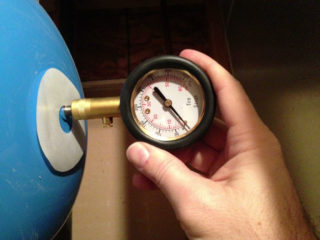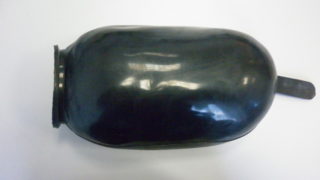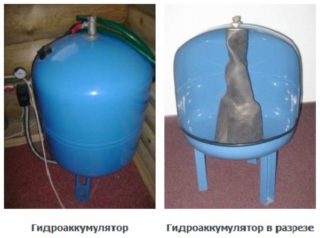An autonomous water supply system, which is based on a pump that pumps liquid from a well or well, in some suburban villages is the only way to provide a private house with water. It works as needed to use water: opening the tap, turning on the pumping device, the flow of liquid. In order to reduce the number of switching on and off of the pumping unit, which reduce its operational resource, a hydraulic accumulator is mounted in the water supply network.
What is a hydraulic accumulator
A rubber bulb filled with water expands by squeezing the air that is pressurized. It turns out that water is always under pressure from the side of the injected air and, due to this, enters the water supply network. As soon as the air parameters are equal to the water parameters, the pump will immediately turn on and begin to fill the pear.
All accumulators on the market differ in size. When choosing a tank, it is necessary to take into account the requirements for the volume of water. The larger it is, the better: the pump will turn on less often.
Maintenance rules

Like all plumbing fixtures, the accumulator has a certain service life. To increase it, it is necessary to periodically carry out maintenance. If the switching on and off of the pumping unit has become more frequent, this indicates that the pressure inside the tank has dropped - an air leak has occurred.
How to adjust air pressure
You can cope with the reason for the frequent activation of the accumulator with your own hands. To do this, you need a pressure gauge that measures the pressure in car wheels. The sequence of operations performed:
- the pump is disconnected from the power supply network;
- any tap or mixer in the water supply network opens to relieve water pressure;
- the protective cover of the nipple is removed, which is located on the opposite side from the inlet pipe;
- a pressure gauge is connected to the nipple;
- the air pressure reading is taken, it must correspond to the parameter specified in the product passport or on a metal plate located on the accumulator body.
If the pressure is much lower than the passport pressure or there is no pressure at all, air is pumped into the tank using a conventional car pump or compressor.
One of the consumers must be opened before injection. Better is the one that is closest to the accumulator. It is impossible to pump air into a tank that is almost completely filled with a pear filled with water.
It is very important to correctly adjust the air pressure. If this parameter is higher than the passport, a situation may arise when the air will squeeze the membrane to the maximum, causing it to shrink. It will be impossible to pump water into it. Therefore, after pumping it is necessary to check the pressure with a pressure gauge. If the indicator is higher than the required one, it is necessary to bleed air.
At the factory, the accumulator is usually filled with nitrogen.This does not mean that gas cannot be replaced with air. You just need to release it first.
It is necessary to check the accumulator for operability once every six months. If the pressure in it drops, then there is a malfunction in the joint between the body and the nipple. This problem is also easy to solve. It is necessary to tighten the nipple or bolts on the flange. Leak testing is usually done with a soapy solution.
Terms of service of the accumulator

There are recommendations from manufacturers that must be used during the operation of accumulators. If you strictly adhere to them, you can almost double the service life of the device.
- Once a month, check for compliance with the set value for turning on and off the pumping unit.
- Once every six months, inspect the accumulator for its external condition: the presence or absence of dents, corrosion, smudges and other things.
- Check the air pressure with a pressure gauge once every six months.
- If the country house will not be used in cold weather, you need to take care of draining the water from the accumulator for the winter.
The hydraulic tank is presented on the market in two versions: horizontal and vertical. Regardless, the service is the same.
Accumulator repair

The reason that can lead to repair work is the rupture of the rubber membrane. Determining that the pear has broken is quite simple. It is necessary to remove the protective roof from the nipple and push it, for example, with a match. If water poured out, it means that the membrane is torn and the liquid has filled the entire tank.
The repair consists in replacing the torn pear:
- the pump is disconnected from the power supply;
- the water pressure in the water supply system is released by opening one of the consumers;
- the flexible hose is disconnected, with which the accumulator is connected to the water supply;
- a wrench unscrews six bolts that attach the flange to the tank body;
- the membrane is pulled out;
- the tank is washed and dried;
- a new membrane is inserted inside;
- a flange is installed, which is tightened with bolts;
- air is pumped through the nipple;
- the accumulator is connected to the plumbing system with a flexible insert.
It is not necessary to use a sealant to seal the joint between the flange and the device body. The rubber bulb, or rather its flange ledge, is itself a sealing element.
Sometimes there are situations where the steel flange of the diaphragm is corroded and cannot perform its function. It just needs to be replaced with a new one. The replacement method is exactly the same. Just don't take the bulb out of the accumulator and rinse it.
The maintenance and repair of a hydraulic accumulator for the water supply system of a private house must be approached responsibly. All manipulations do not take much time. But it is on them that the operability of the tank with the pump depends, and their long-term trouble-free operation. If it is not possible to carry out repairs on your own, for example, the flange bolts are not unscrewed, it is recommended to take the accumulator to a service center. A torn thread or a broken bolt is a breach of the tightness of the instrument.









